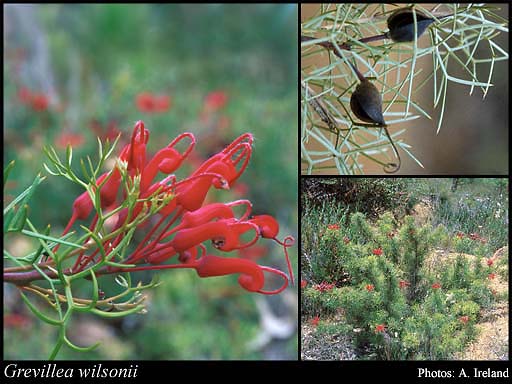- Reference
- T.B.Wilson, Voy.Round the World 273 (1835)
- Conservation Code
- Not threatened
- Naturalised Status
- Native to Western Australia
- Name Status
- Current
Erect, compact to spreading, lignotuberous shrub, 0.4-1(-1.3) m high. Fl. red, Jan or Mar or May or Jul to Nov. Grey sand, sandy loam, lateritic gravel.

Scientific Description
Shrubs, 0.8-1.5 m high; branchlets glabrous or hairy, not glaucous. Leaves alternate, 20-60 mm long, hairy, on the adaxial or abaxial surface, the hairs straight; lamina flat, twice or more divided, pinnately divided, divided to the midrib; lobes 5-30 mm long, 0.5-1 mm wide, the margins revolute, enclosing the lower surface of the leaf blade, forming a groove either side of the midvein. Inflorescences terminal, red; pedicels 10-15 mm long. Perianth 18-20 mm long; tepals some joined and some free after flower opens, glabrous; ovary hairy, stipitate, the stipe 2-3 mm long; pistil 28-35 mm long, red, pollen presenter oblique, style hairy. Follicles hairy, not viscid, dehiscent, 15-18 mm long. Flowers in July, August, September, October, November or December. Occurs in the South-west (SW) Botanical Province(s), in the Swan Coastal Plain (SWA), Avon Wheatbelt (AW) or Jarrah Forest (JF) IBRA subregion(s).
Distribution
- IBRA Regions
- Avon Wheatbelt, Jarrah Forest, Swan Coastal Plain.
- IBRA Subregions
- Katanning, Northern Jarrah Forest, Perth.
- Local Government Areas (LGAs)
- Armadale, Boddington, Brookton, Bunbury, Gosnells, Harvey, Kalamunda, Mundaring, Murray, Northam, Serpentine-Jarrahdale, Swan, Toodyay, Wandering, Waroona.